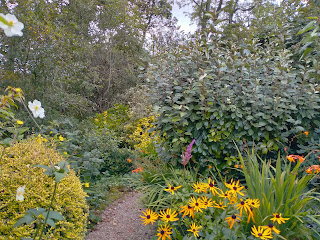When the Railway came to Cumbria
The Railway came to Windermere in 1847 and to Keswick in 1864.
With the railway came visitors from Northern industrial cities - Leeds, Manchester, Liverpool, Middlesbrough and Newcastle. The wealthy purchased land, built houses and created gardens. Plant hunters were employed to bring rare species to these gardens. This was a horticultural boom time in Cumbria and the Lake District.
Today Cumbria is almost swamped with horticultural treasures.
At the end of the last great Ice Age, 8000 years ago, there appeared a poor and mean landscape full of waterlogged sedges, ferns; probably less than two hundred plants that had survived the onslaught of millions of years of ice. The plants included the bilberry (Vaccinum myrtillus), sundew (Droseras), some Alchemillas and the Teesdale Violet (Viola rupestris).
So where did the plants we see today come from?
Cumbria, with some of the oldest mountains in the world, is a county where non native species were introduced to the lives of those developing new gardens by the plant hunters these people commissioned. Most of the new flora, fauna and trees were introduced between 1837 and 1910.
To the west the county is basked in the warm, wet blanket of the Gulf Stream. To the east it is protected from strong winds by the North Pennines, the backbone of England.
Today we are able to enjoy rare species imported by men who risked their lives all over the world to bring rare plants into our lives. In the present day we can experience the thrill of the hunt without the hardships experienced by those whose quest was to discover uncommon, often exceptional specimens.
Unusual places to see rare plants and gardens in Cumbria include:
Lancrigg Country House Hotel, Easedale, Grasmere – once the home of Sir John Richardson (1787-1865). Born in Dumfries on the 5th November, John Richardson studied medicine in Edinburgh and became a naval surgeon in 1807. His first Arctic Expedition, as Surgeon and Naturalist, was with Sir John Franklin (1786-1847) from 1819 – 1822 He was best friends with Charles Darwin (1809-1882) and married the daughter of Elizabeth Fletcher, a good friend of poet William Wordsworth (1770-1850).
William Wordsworth paid £1030 for Lancrigg on behalf of his friend in 1840 and landscaped the gardens and surrounding woodland, some 30 acres, with rare plants and trees.
Rydal Hall, Rydal, near Ambleside – leased by the Diocese of Carlisle – there has been a house on this site since the beginning of the 17th century but most of the building, as seen today, stems from the 18th and 19th century. At the time it was the centre of the thriving estate of the Le Fleming family.
In 1909 Thomas Mason (1861-1933), in spite of his spreading world fame, designed the formal gardens at Rydal Hall. Double stairs descend to a wide central path that bisects the rectangular garden. In the centre is a large circular pool with a fountain. The current outdoor/nature textile exhibition in the gardens by Dianne Standen is the largest in the UK – her studio is near Cockermouth.
Lingholm, Portinscale, near Keswick – this estate is of importance because Beatrix Potter (1866-1943) spent 10 summer holidays over a 22 year period here. The house was built in the 1870’s for Colonel Greenall, but the gardens were not laid out until early in the 20th century when Colonel George Kemp, later to become Lord Rochdale, owned the house. On the shores of Derwentwater the gardens are vast and take in large sweeps of woodland that stretches on low hills. The gardens and terraces have a collection of rhododendrons, azaleas and woodland flora many of which are now open to the public.
The Fairfield, Brantfell Road, Bowness on Windermere – the half acre garden laid out over 120 years ago by Annie Garnett (1864-1942) of the Spinnery. Annie Garnet was a famous textile and water colour artist, one of the instigators of the the Lakes Linen Industry and member of the Lake District Arts and Crafts Movement. The garden contains rhododendrons, magnificent azaleas and a wisteria over 160 years old. There are extensive borders and a croquet lawn. The grounds were once part of the Crown Rigg Estate and were given to Fairfield House as a dower house for the use of the widow of the deceased owner.
Lindeth Fell Country House Hotel, Lythe Valley Road, Windermere – Thomas Mawson nearly had a monopoly on designing of the larger gardens of the Lake District. Often he designed the house as well as the garden and nearly always used Pattionsons of Windermere to build and carry out his designs. Lindeth Fell was constructed by the Pattinson firm and laid out from 1907 to 1909. Today after a variety of owners it belongs to the Kennedy family and is a country house hotel. The original Mawson layout in the garden largely remains but it is reduced to just 8 acres based on a series of informal terraces and lawns.
Today we can place plants and trees in our own gardens, watch them grow, develop - harvest flowers and crops. Before long we can take cuttings, collect seeds and share our plants with our friends. In our own way we can become modern plant hunters.
Salvia and Dahlia from Mexico in my garden this Autumn
+







Comments
Post a Comment